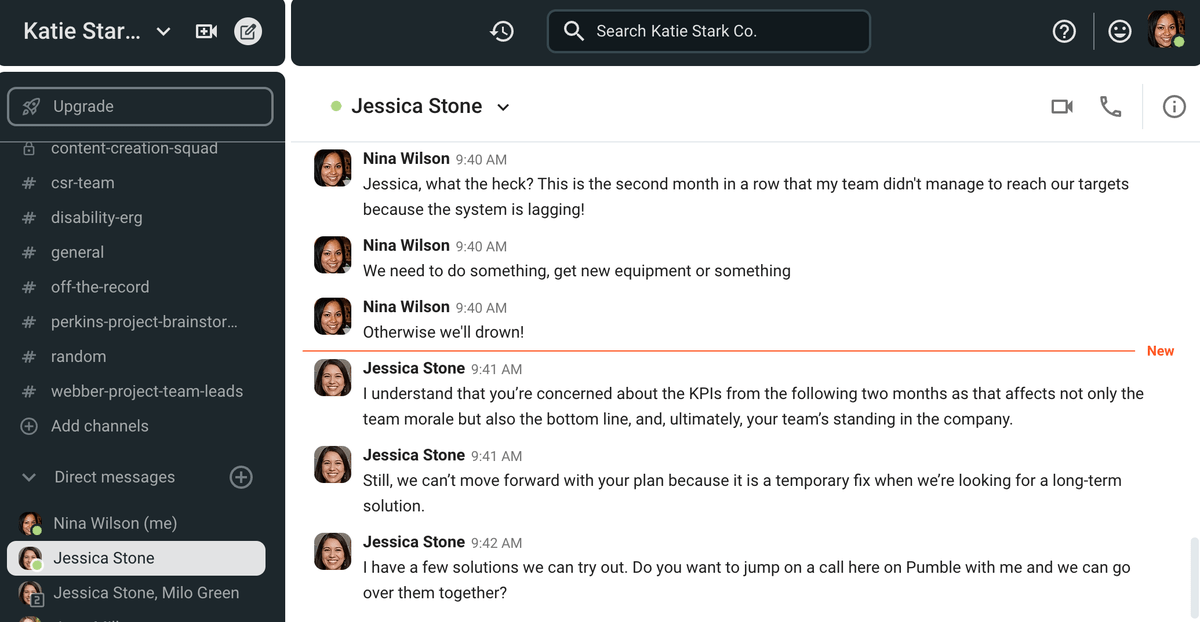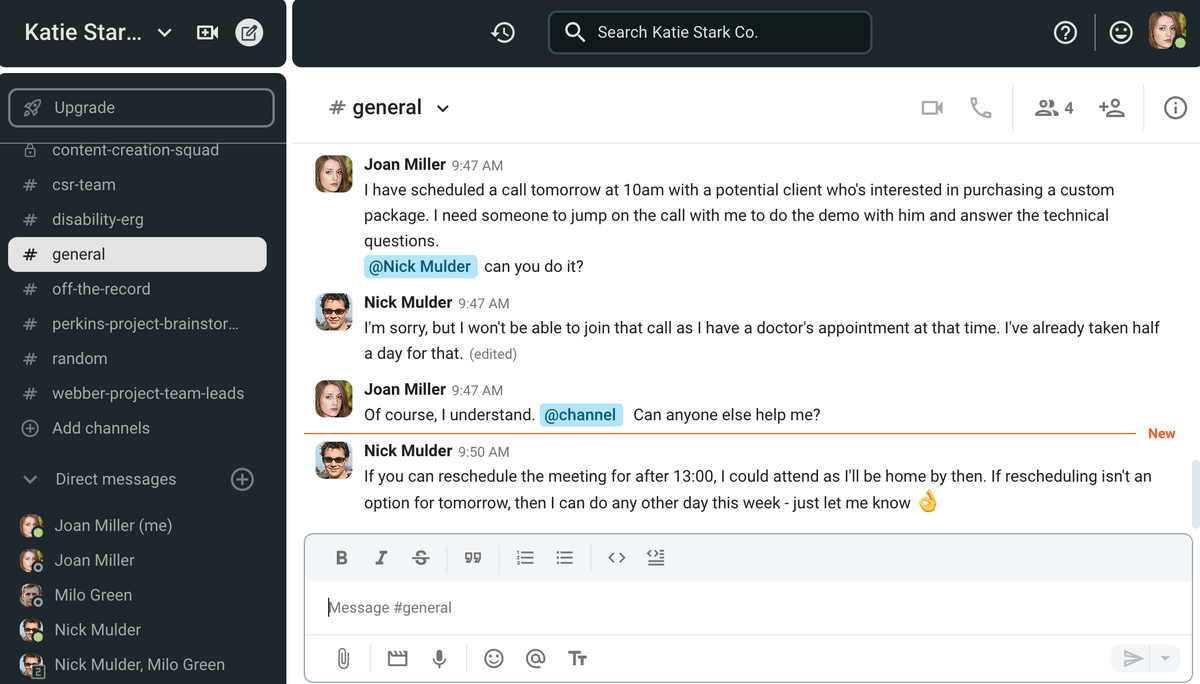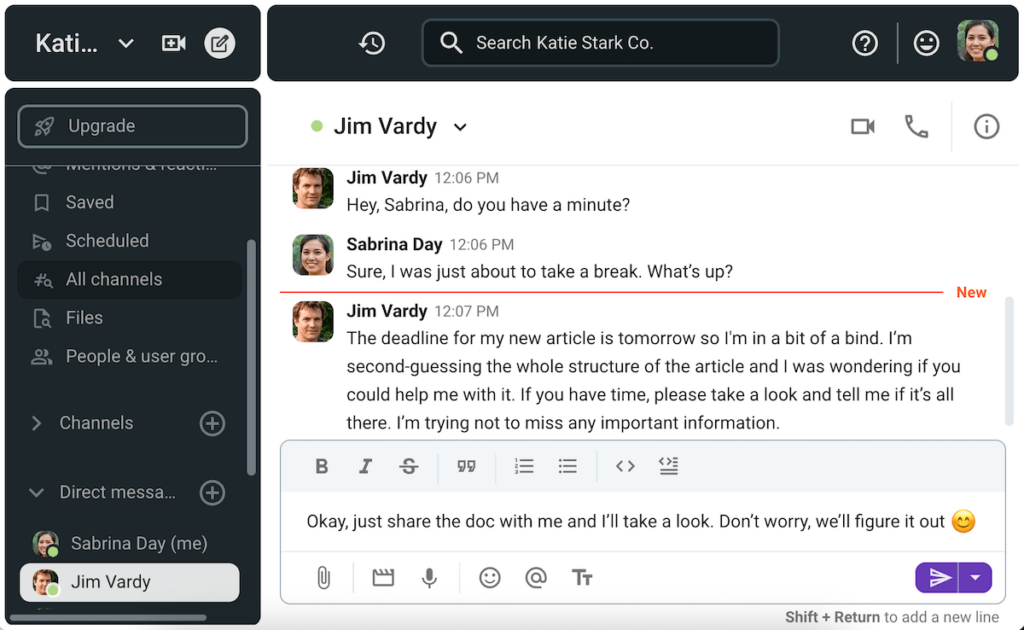You’ll often hear people tell you that you need to be more assertive in the workplace and fight for your rights.
But, what does being assertive even mean?
What is assertive communication?
How can it benefit you personally?
And, what must you do to attain that communication style that has almost magic-like effects in the workplace?
In this blog post, we will
- Answer those and many other questions,
- Give you the best examples of assertive communication, as well as
- Provide you with practical tips that will help you become the most effective communicator you can be.
Let’s get started.

- Assertive communication is a communication style that allows you to get your point across while being respectful to both yourself and others.
- For example, instead of saying, “What do you mean I didn’t get the promotion? I’m the best worker you have! You’ll regret this!” you can say, “I’m disappointed I didn’t get the promotion. Can we talk more about why I wasn’t selected so I know what I can do differently or better in the future.”
- To be more assertive in the workplace, you should:
- Practice active listening,
- Say “No” more,
- Propose solutions,
- Use “I statements”,
- Control your body language,
- Avoid euphemisms,
- Cut to the chase, and
- Remain calm.
Table of Contents
What is assertive communication?
Assertive communication is a communication style that allows you to get your point across while being respectful to both yourself and others. Assertiveness is a sought-after interpersonal communication skill that allows you to voice your needs, desires, and opinions without infringing on others’ boundaries.
Thanks to assertiveness in the workplace, you can maintain healthy relationships with your coworkers without stifling your own needs and easily resolve conflict.
By definition, assertive communication is the middle ground between aggressive and passive styles of communication — something all workers strive for but many struggle with.
Example of assertive communication in the workplace
An assertive communicator knows how to:
- Get their point across effectively,
- Be mindful of their own needs without disregarding those of others, and
- Handle unpleasant communication situations without succumbing to negative emotions.
But what does assertive communication mean in terms of being more assertive in the workplace?
Let’s say that you had a disagreement with one of your coworkers about the way you should implement a new interviewing protocol.
Your coworker proposed that the interviewees get a test assignment before the actual interview and work on it at home. You aren’t that keen on that, given that the test is an indicator of the interviewees’ skills, strengths, and weaknesses, and doing it in real time gives you a better assessment of all 3 aspects.
There are 4 different ways you can communicate that:
- Aggressively,
- Passively,
- Passive-aggressively, and
- Assertively.
Take a look at the table below to see clear differences between these 4 styles of communication.
| Style | Example |
|---|---|
| AGGRESSIVE STYLE | “No, that’s stupid. Don’t argue with me and do what I said.” Or “I like my idea better so that’s what we’re doing.” |
| PASSIVE STYLE | “Well, I guess. We can do whatever you want.” Or “I’ll go with whatever you decide.” |
| PASSIVE-AGGRESSIVE STYLE | “If those are your suggestions, don’t even bother. I’ll do it myself.” Or “For future reference, if you don’t want to hear my opinion then just don’t ask me, and do what you think you should.” |
| ASSERTIVE STYLE | “Since we disagree, let’s try to find a solution that works for both of us.” Or “That’s a valid point, but I think going a different route might be more beneficial because…” |
These examples, although illustrative, don’t cover all the nuances of assertive communication — so keep an eye out for more practical examples of assertive communication throughout the text.
How to be more assertive in the workplace
Ever since the term the 7 C’s of Communication was coined as the pinnacle of effective communication in the book Effective Public Relations back in the 1950s, great efforts have been made to format any communication-related advice into a bullet point of adjectives beginning with the letter C.
That’s why you’ll often find advice that states that being an assertive communicator has everything to do with the 3 C’s of assertive communication or the 5 C’s of effective communication.
In reality, there are more than 3 (or 5) characteristics of assertive communication and, therefore, things you need to do to be more assertive, which is why our concrete tips that will help you become more assertive in the workplace don’t fall into the neat alliteration — we ran out of words beginning with C.
Still, all the tips are solid, so let’s take a deeper look at each one.
Tip #1: Practice active listening
To be able to communicate your needs and opinions adequately, you first need to listen to others because that’s the only way you can get an understanding of where they are coming from.
That’s why practicing active listening is at the very top of our list of tips.
Active listening allows you to recognize and avoid miscommunication as well as put the other person at ease since they won’t feel like you’re attacking them because you disagree. Thus, you’ll create a safe space for the discussion that’s going to take place.
Active listening is the top tip for all aspiring assertive communicators according to Dr. Deborah Gilman, Owner and Chief Licenced Psychologist at Fox Chapel Psychological Services, because it sets the right stage.

“Active listening involves genuinely concentrating, understanding, responding, and remembering what is being said. By actively listening, you not only gain a deeper understanding of others’ perspectives but also show respect for their thoughts and feelings.
This sets the stage for clearer, more empathetic, and assertive responses, fostering stronger connections and more effective communication overall.”
An example of an assertive communicator who actively listens
During a disagreement that causes a conflict in a team, an assertive communicator will:
- Actively listen to the concerns of others,
- Address each of them, and
- Provide a clear argument that shows they not only understand what the other person is saying but also validate their feelings.
A good example of assertive statements in those situations would be:
“I understand that you’re concerned about the KPIs from the following two months as that affects not only the team morale but also the bottom line, and, ultimately, your team’s standing in the company. Still, we can’t move forward with your plan because it is a temporary fix when we’re looking for a long-term solution. Here’s what I propose we do instead…”

💡 Pumble Pro Tip
Assertive communication is vital for creating psychological safety in the workplace. To find out what else can contribute, read our blog post:
Tip #2: Say “No”
Assertive communicators know where their boundaries are and work to maintain them. While they certainly don’t go out of their way to disagree with others, they know how and when to say “No”.
Always remember that the key to being assertive is balancing your wants and needs with those of others.
If you completely disregard everyone around you, you’re not being assertive; you’re being aggressive. On the other hand, if you put the wants and needs of others above yours, you’re being passive, which is bound to result in self-resentment down the line.
This is a fine balancing act to master, but those who master it will always find the best way to make and suggest compromises. What’s characteristic about an assertive communicator’s “No” is that it is always followed by “Because”.
Saying “No” isn’t easy, but being an assertive communicator is all about having difficult conversations, according to our contributor, Erik Pham, CEO of Health Canal and Media and Communication expert with over 10 years of professional experience.

“Assertive individuals are willing to communicate openly. This means they express their thoughts and feelings even when it is difficult. By doing so, they establish clear expectations and contribute to a healthier and more respectful dialogue.”
An example of an assertive communicator saying “No”
Here are two examples of assertive communicators saying “No” to extra work and then immediately giving valid arguments as to why they did so:
“I can’t get started on the new project before next week because I already have my hands full and I wouldn’t want either project to diminish in quality.”
“I can’t work an extra shift on Friday because I’m going on a weekend retreat and I’ve already booked the transport and accommodations.”

💡 Pumble Pro Tip
Saying “No” is a particularly hard task for most employees, especially when you have to follow up with “That’s not my job”. To learn how to say that respectfully and professionally, check out our blog:
Tip #3: Propose solutions
Saying “No” in a clear and assertive manner isn’t enough.
An assertive communicator worth their salt will also take the initiative in proposing potential solutions. As clear and open communication is one of the key elements of good team collaboration, an assertive communicator will improve the productivity of collaboration in their team.
As stated by Dr. Gilman, proposing solutions is an excellent way of maintaining an assertive style of communication in the office. It’s also a gift that keeps on giving — the more you practice an assertive communication style (by proposing solutions), the more you enhance your problem-solving abilities.

“By expressing opinions and concerns directly yet respectfully, assertive communicators stimulate constructive discussions. This aids in:
- Identifying issues,
- Brainstorming solutions, and
- Propelling effective problem-solving initiatives.”
An example of an assertive communicator proposing solutions
Let’s say that a meeting that requires your presence is suddenly scheduled for tomorrow morning. No one has run this by you. If they had, they would have known you have a doctor’s appointment scheduled for tomorrow morning.
Instead of getting defensive, laying blame, or simply freaking out in this situation, an assertive communicator will compose a response like this:
“I won’t be able to attend the meeting tomorrow because I have a doctor’s appointment at the same time. I will be back home by 13:00, so any time after that works for me if we can reschedule for the same day. If that’s not an option, I am available all day the day after tomorrow. Let me know what you think.”

By saying this, our imaginary assertive communicator has:
- Reaffirmed their boundaries,
- Explained why they cannot or will not do what is asked of them in a calm yet direct (and perfectly reasonable) manner, and
- Proposed potential solutions.
Tip #4: Use first-person singular (or “I statements”)
Notice how, in the previous example detailing how an assertive communicator may compose a message, every statement begins with I.
These so-called “I statements” allow you to communicate your thoughts and ideas directly without sounding accusatory. They offer insight into your thoughts and feelings and diffuse tension.
If you’re not sure how the “I statements” should work, our contributor, Nick Padlo, the CEO of Sophros Recovery, a mental health treatment facility with a curriculum that focuses heavily on relationships and communication strategies, proposes setting up a few templates:

“My top tip is to establish a template for some of these assertive conversations that include “I statements”. The template should include statements that empathize with the other person’s perspective, and suggest a way of working going forward. There are many tools online like DEESC scripts, but find what works for you. Even if you don’t stick with the template, starting there reduces the chances that you will slip into old, ineffective communication patterns.”
An example of an assertive communicator using “I statements”
If you aren’t satisfied with the quality of a job handled by your subordinate, instead of saying “This is rubbish,” or “You didn’t do this well,” you could say:
“I am not satisfied with this,”
or
“I feel you could have done this better”.
Egocentric as it may sound, when every sentence you utter revolves around yourself, it can alleviate some of the pressure your interlocutors would otherwise feel.
This isn’t a technique used exclusively for giving feedback. If a group decision has to be made, you can also take the initiative by giving your opinion (and possibly elaborating on it) before passing the baton off to the next person.
For example, if the team is deciding on the best marketing strategy for their new product, you may say:
“I think affiliate marketing would work best (because our target audience is Gen-Z who are difficult to reach with other marketing strategies due to their ubiquitous use of ad-blockers). What do you think?”
Tip #5: Control your body language
Assertive communication consists of more than just our choice of words. Elements of non-verbal communication, like gestures, body language, and eye contact, are vital parts of active communication and play a huge role in how effectively we can establish ourselves as assertive communicators in the eyes of others.
To be an assertive communicator, you need to:
- Have a composed facial expression,
- Maintain eye contact,
- Have a firm yet welcoming posture,
- Speak in a calm, even tone of voice, and
- Avoid dramatic hand gestures, and
- Respect other people’s personal space.
There’s a stark difference between all non-verbal cues when it comes to assertive and aggressive or passive communication. Take a look at the table below to see what they are.
| Passive style | Assertive style | Aggressive style | |
|---|---|---|---|
| Facial expressions | Sulen or disinterested | Calm and composed | Judgmental facial expressions |
| Eye contact | Avoids eye contact | Maintains eye-contact | Staring |
| Posture and body language | Insecure slouching | Firm but welcoming | Closed off |
| Tone of voice | Soft or weak | Firm | Aggressive and loud |
| Gesturing | Little or none | Moderate | Overly dramatic |
| Proximity | Stands far away | Respectful | Often occupies other people’s spaces |
An example of an assertive communicator controlling their body language
Maintaining a composed body language and especially steady eye contact without looking as if you’re scrutinizing the other party isn’t easy. That’s especially true in remote workspaces, where you’re left relying on modern technology such as video conferencing to speak face-to-face with your coworkers.
But, an assertive communicator will find their way even in that situation.
For example, while communicating with their coworkers remotely, they will try to keep their tone of voice neutral and calm, their posture upright, and, most importantly, they will maintain eye contact even through the camera.
As counterintuitive as it sounds, to achieve this, you need to look directly at the camera. That way, your interlocutor will feel like all of your attention is placed on them. Group conference calls give you the added benefit of making every person present feel like you’re giving them (and them alone) your undivided attention.
Tip #6: Avoid euphemisms
Euphemisms have their upsides, but there is a time and place for them.
For example, there are some life situations when you’ll want to soften the blow your words can have as much as you can. When giving condolences to a colleague who just lost a dear one, you will probably refer to the deceased as “no longer with us” rather than “dead”.
But in the workplace, especially for remote or hybrid teams, euphemisms mostly serve to impede communication.
Assertive communication is marked by its direct approach, as stated by Dr. Gilman, who further explained the multitude of benefits that it carries.

“Assertive communication involves expressing thoughts and needs directly and clearly. This clarity eliminates ambiguity and ensures that messages are conveyed accurately. When individuals communicate assertively, there’s less room for confusion or misinterpretation, leading to a shared understanding among team members.”
This clarity is vital not only on an individual but also on a team level, she continued.

“Clear communication enhances task comprehension within a team. When instructions or expectations are communicated assertively, everyone involved understands their roles within the team, responsibilities, and objectives clearly. This results in more efficient workflows and reduces errors arising from misunderstandings.”
So, it’s clear that a figure of speech whose sole purpose is to avoid directly conveying your message is incompatible with assertive communication, as assertive communication is direct communication.
An example of an assertive communicator avoiding euphemisms
If you’re a manager who’s running short on people to work a shift, don’t contact an employee who’s supposed to have the day off with this type of message: “Janet called in sick last minute… We’re going to be short-handed for the second shift tomorrow… It’s going to be really busy… I’m not sure how we’ll handle it…”
It happens more often than you’d think.
The message the manager is trying to communicate here is:
“Can you come in for the second shift tomorrow? (Janet called in sick.)”
And that’s exactly how you should phrase such a request if you’re wondering how to be more assertive at work — directly and honestly.

💡 Pumble Pro Tip
Euphemisms can be a serious communication barrier. To find out more about how communication barriers impede assertive communication, as well as how you can address them, read our full guide:
Tip #7: Cut to the chase
Conciseness is important to effective assertiveness because by beating around the bush, you’re essentially increasing the tension.
By nature, all business communication should be concise, as the office is no place for Shakespearean monologues. However, many people fall into the trap of overcommunicating in the workplace in an effort to explain themselves or even preemptively defend themselves.
An assertive communicator will do neither, as stated by Dr. Gilman, who highlighted that by being concise, assertive communicators also allow themselves the opportunity to express their thoughts and concerns directly (thus increasing the chances their concerns will be addressed).

“Assertive communicators voice their opinions and concerns directly but respectfully. This directness facilitates the identification of underlying issues without beating around the bush. It encourages transparent discussions focused on problem-solving.”
So, to become a better assertive communicator, you have to:
- Be transparent when communicating,
- Avoid unnecessary business jargon, and
- Avoid over-the-top explanations that aren’t relevant to the topic.
This further helps the assertive communicator keep their communication solution-based (rather than problem-based).
An example of an assertive communicator cutting to the chase
Let’s say you have some bad news to deliver to your coworker — you have to say “No” to their idea, for example.
You might be inclined to prolong the conversation or have a really long intro before actually breaking the news to them, like this: “Listen, you know how much I value your ideas and how great I think you are. In fact, you’re so great that I regularly tell the higher-ups that they should listen to you. Hey, remember that one time when you had to finish the spreadsheets quickly, and you got the brilliant idea to copy/paste the parameters so you can go through them quicker? Now that was something!”
An assertive communicator will never do that. Instead, they’ll concisely (but respectfully) say what they have, which will look something like this:
“Hey, I’m sorry to break this to you, but your idea has been rejected due to the lack of resources. It was a great idea, and I regret that we can’t implement it right now.”
💡 Pumble Pro Tip
Being concise is a great way to break bad news or have difficult conversations. But what happens when the person you’re dealing with is being difficult? To get some help in that area, read our guide:
Tip #8: Don’t apologize
How many times a day do you apologize at work?
Probably too many.
Although you’d think that constantly apologizing is appealing to other people and, thus, one of the characteristics of assertive communication, avoiding saying “Sorry” at work actually makes you more assertive than the other way around.
For example, instead of saying “I’m sorry for being late” you can say:
“Thank you for your patience.”
Constantly apologizing is an unproductive habit. Workers who constantly apologize come across as defensive or in the habit of dwelling on the negatives. This makes it difficult to place focus on what’s important, which is what comes next.
Owning up to your mistakes or shortcomings is better done by holding yourself accountable and providing a plan of action that will make up for the mistakes and prevent their reoccurrence.
An example of an assertive communicator not apologizing (but still being accountable)
Let’s say you need some help from a coworker — you’ve hit a roadblock while working on a task and you need some help.
To come across as assertive (rather than passive), instead of saying something along the lines of, “I’m sorry to bother you, but could you help me with…” or “So sorry to add to your busy day, but I need…”, ask them for help and thank them for it.
You’ll be surprised how many Sorrys during our workday could be exchanged with a “Thank you”.

💡 Pumble Pro Tip
Although you shouldn’t over-apologize at work, you also have to know when and how to say “Sorry”. Our blog post below can help you with that:
Tip #9: Remain calm
Calmness is another defining characteristic of an effective assertive communicator. It is the key ingredient to making all the other techniques function as intended.
If this sounds impossible to accomplish, remember that other assertive communicators you’ve met are also human. No one is immune to negative emotions. However, an assertive communicator will take the time to work through them. Unless it is impossible, they will not engage in communication until they have regained a proper handle on their emotions.
How to be assertive at work without being aggressive
For many, the notion of coming off as aggressive is the biggest hurdle standing in the way of achieving assertive communication. But aggression and assertiveness are fundamentally different.
Everything an assertive person does — from how they hold themselves to how they express their needs — is different from the behavior an aggressive person exhibits, as illustrated in the table below.
| Assertive communicator | Aggressive communicator |
|---|---|
| Expresses their needs firmly but respectfully | Forces people to please their own needs with no regard for others’ feelings |
| Compromises frequently, in an effort to reach an optimal solution | Never compromises and is prone to “My way or the highway” behavior |
| Builds new and strengthens existing relationships | Damages existing relationships and debilitates the creation of new ones |
| Uses clear language | Uses strong, aggressive language |
| Builds self-esteem (their own and of others) | Destroys self-esteem (their own and of others) |
| Treats others with respect | Treats others like a bully |
Aggressive communication is characterized by:
- Judgment,
- Argumentativeness, and
- Disagreements.
Aggressive communicators are also the ones most likely not to allow the other person to get a word in edgewise.
Conversely, assertive communication is about being:
- Honest,
- Direct, and
- In control of your emotions.
To ensure you can correctly recognize (and control) your emotions and behavior in the workplace, you should work on your emotional intelligence — as our contributor, Jessica Nevitt, SHRM-SCP and Lecturer at the Indiana University Kelley School of Business noted.

“To be more assertive, it is important to increase personal emotional intelligence. The more aware we are of our emotions, how we react, and how others react to us, the more confident we are in expressing what we need or want in the workplace.”
Examples of being assertive in the workplace (without being aggressive)
For those looking for real assertiveness examples, you can take a look at the table below to see how an aggressive and an assertive communicator might react in different situations.
To highlight the differences between them, while also ensuring you don’t go too far (into apathy or people-pleasing), we’ve also included what a passive response might look like.
| Scenario | Aggressive response | Passive response | Assertive response |
|---|---|---|---|
| A coworker was late for an important meeting | “You’re always so irresponsible and you never do anything right! I had to cover for you and I looked like an absolute fool!” | “Eh, whatever, it doesn’t matter that you were late. I scrambled a bit to keep the meeting on track, but who cares?” | “I’m quite disappointed you were late for the meeting. Would you like us to make a system that will help us to deal with this in the future?” |
| Your manager passes you up for a promotion | “What do you mean I didn’t get the promotion? I’m the best worker you have! You’ll regret this!” | “Well, I wasn’t really hoping to get a promotion anyway.” | “Hey, I would like to schedule a meeting with you to get some feedback on why I wasn’t selected and some guidelines on what I can do differently or better in the future.” |
| Your employee is late for work for the third time in 2 weeks | “Do you think your work hours are optional? Well, they aren’t, buddy! You need to get to work when I tell you, not when you think you should!” | “Sure, it doesn’t matter, I wasn’t even aware you were late. It’s OK.” | “I noticed this isn’t the first time you didn’t manage to get to work on time. Did something happen? Do you need us to sit down and talk about it?” |
So, as we can see, what separates assertive communicators from aggressive ones is that they:
- Clearly state their needs and feelings,
- Don’t force their opinions on others,
- Acknowledge the needs and opinions of others, instead of disregarding them, and
- Offer solutions.
Benefits of assertive communication for remote workers
Now that we’ve seen how to be assertive in the workplace (with examples), it’s time to answer the question of, “Why bother?”
According to Mayo Clinic, the benefits of assertive communication on our emotional well-being are profound. More importantly, they aren’t limited to the workplace.
By following the tips in this blog post and becoming a more assertive communicator, you’ll be able to enjoy the following benefits:
- Increased self-confidence,
- Higher job satisfaction, and
- Profound introspection.
Benefit #1: Increased self-confidence
Most often, it is passive communicators who are looking to become more assertive. Passive communication is marked by placing the needs of others before your own, whereas assertive communication balances your needs with the needs of others.
This requires learning to stick up for yourself. Passive communicators avoid conflict at all costs, but the great thing about assertive communication is that it’s not conflict-driven. For example, by following our tips you’ll learn how to say “No” in a manner that won’t offend any reasonably-minded individual.
Learning to stand up for yourself like this will inevitably boost your self-confidence and self-esteem levels, which can help you lead a more fulfilling life.
Benefit #2: Higher job satisfaction
Few people enjoy conflict, but avoiding it isn’t the solution. By learning how to effectively deal with conflict when it arises, assertive communicators can feel less stressed while working.
As our contributor, Dr. Gilman, stated, conflict resolution and subsequent diminishing of stress is a major benefit of assertiveness — assertive communicators can overcome conflict or even prevent it in the first place.

“Assertive communication can prevent conflicts from escalating into larger issues. By respectfully addressing concerns and opinions upfront, potential conflicts are nipped in the bud. This proactive, assertive approach builds trust among team members and prevents resentments from festering.”
Anything that reduces stress and burnout is bound to lead to higher job satisfaction, especially in a remote work environment where over 85% of all workers suffer from these issues (compared to less than 70% of in-person employees).
Benefit #3: More profound introspection
Because none of the other types of communication (passive, aggressive, or passive-aggressive) promote the actual articulation of feelings, they don’t provide fertile ground for introspection.
A strong understanding of oneself is essential for an assertive communicator — they need to know:
- Where their boundaries are,
- What makes them tick (so they can effectively manage it), and
- What their strengths and weaknesses are.
These qualities are also invaluable to the peaceful pursuit of one’s dreams.
Pumble: An effective means of assertive communication
The detriments of poor communication are many, not least of which is monetary loss. With poor communicators in the team, the chances for miscommunication are higher.
One of the best ways to improve your assertiveness is by maintaining an open line of communication with your coworkers and employees.
And what better way to do that than with Pumble, a team communication and collaboration app that is the backbone of many remote, hybrid, and on-site teams, as it allows them to directly communicate with each other via:
- Direct messages,
- Threads,
- Channels
- Audio calls, and
- Video conference calls.
What’s more, Pumble helps assertive communicators make their boundaries known by offering:
- Different statuses,
- Scheduled messages,
- Unlimited message history that allows asynchronous communication, and
- Comprehensive notification settings.
Easy to use and customizable, Pumble is the ideal tool for assertive communication. See how it can transform your team communication and collaboration — try Pumble today!




